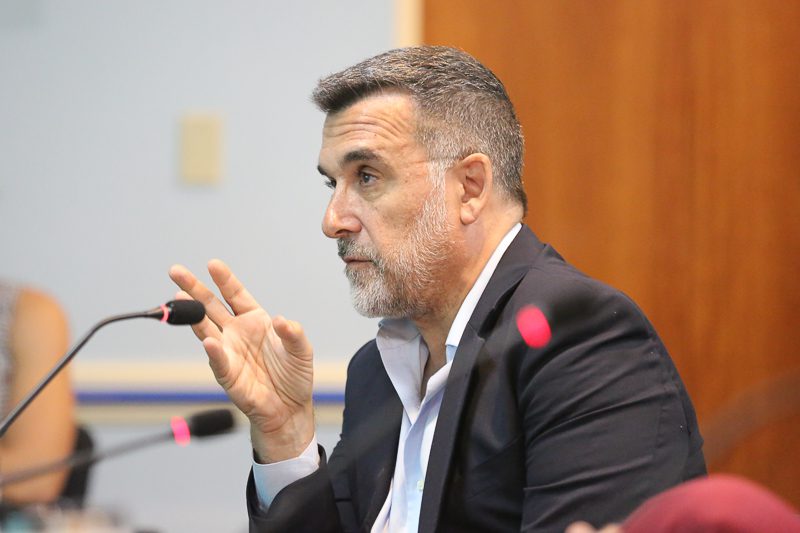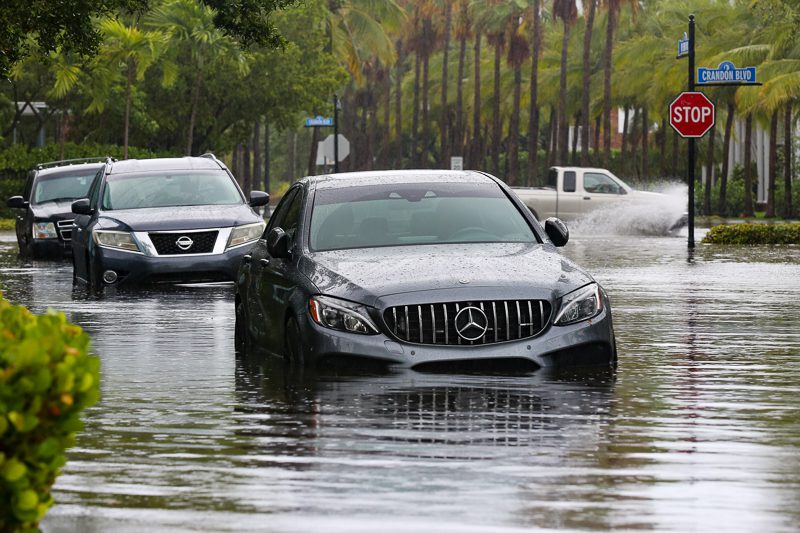With a $310 million estimate in front of them, Key Biscayne leaders are scaling back an ambitious plan to address sea level rise with miles of pressurized pipes, pumping stations, and raised roads.
The storm water plan used a set of targets and assumptions – adopted last year – about rainfall, sea level rise, and how much street flooding island residents would tolerate.
On Thursday, the Village’s consultant said by using different models and by limiting the time frame to 2040 instead of 2060, the amount of runoff water needed to be removed could be reduced by as much as 23%.
If the system has to remove less water, said AECOM manager Tom McGowan, it could bring down the cost of the project, but he was careful not to make any projections. Before AECOM comes up with price tags, the Village Council will have to formally revise the targets.
The changes discussed Thursday:
- Revising downward the “big storm” definition so that the system could remove water from a storm that dumps 7 inches of rain, instead of one that dumps 8 inches of rain in a 24 hour period.
- Allowing some water to pond above the minimum road crown instead of just in swales
- Changing the acceptable ponding depth from “zero to six inches” to “no more than six inches”
McGowan presented rainfall data to back up the recommended changes, noting that FEMA would accept a 7-inch rainfall metric for a big storm. But Council Member Fernando Vazquez said relying on just past data might not protect the island enough.
“You’re looking at a 1999 curve, we’re designing for 2060,” he said. “Because we’re not designing for the past, we’re designing for the future.”
But McGowan said the daily rainfall amount isn’t the driving factor – it’s rain rate per hour that matters. “Does it overwhelm the pump or not?,” he asked – noting pumps the Village purchases would be designed to handle all but the most intense downpours – and even those would clear streets in a matter of hours.

Brian McNoldy, a meteorologist at the University of Miami’s Rosenstiel School, said while long-term climate models predict more rain – and more intense rain events – policy makers have to consider how robust a system needs to be and balance it with costs.
“As for changing the goalposts, they kind of are,” McNoldy said., “But that’s not unusual in engineering.”
He compared the Village’s choice to that of a consumer buying medical insurance.
“If you are willing to spend a lot of money, you can get great coverage and a low deductible. But to be more financially practical, you’re going to have to accept worse coverage and a higher deductible,” he said.
He continued: “As we get older, it takes more to keep us healthy and fix things that need fixing. That’s like sea level rise and increasing rainfall changing the baseline we have to plan for.”
Village resilience chief Roland Samimy said officials were making progress in another huge cost area – obtaining easements for outalls that could accommodate much larger pipes to carry water into Biscayne Bay. He said the Village was reaching out to the St. Agnes and Crossbridge Churches, the Yacht Club, and homeowners about getting those permissions.
But one potential obstacle will be water dissipator boxes at those locations. Dissipator boxes are structures that reduce the velocity of water being pumped into the Bay, needed to protect fragile sea grass and marine life.
Village Manager Steve Williamson has a public presentation set for Nov. 8th, followed by the Nov. 14 regular council meeting where he will ask the Village Council to give AECOM clear direction about the new performance targets.
The changes discussed at the workshop meeting only related to the storm water issue and did not include burying power lines. Williamson said the utility undergrounding project is expected to cost $15 to $20 million.
Invest in Local News for Your Town. Your Gift is tax-deductible
Tony Winton is the editor-in-chief of the Key Biscayne Independent and president of Miami Fourth Estate, Inc. He worked previously at The Associated Press for three decades winning multiple Edward R. Murrow awards. He was president of the News Media Guild, a journalism union, for 10 years. Born in Chicago, he is a graduate of Columbia University. His interests are photography and technology, sailing, cooking, and science fiction.



